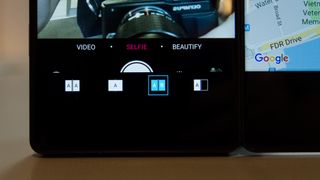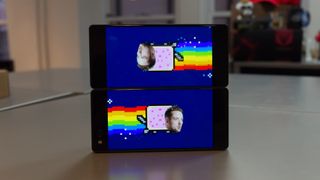Why you can trust TechRadar
Software and reliability
When viewed in single-display mode, the ZTE Axon M operates like 99% of all other Android smartphones. Promised to receive Android Oreo in the near future, for now, it’s loaded with Android Nougat 7.1.2. As such, you’ll find stock features like split-window multitasking with ZTE’s own layer over top of it. It’s reminiscent of stock Android, but unique in a few ways.

First of all, ZTE’s software treats the app drawer in a similar manner to the Google Pixel, asking users to slide up from the bottom to access what’s hidden offscreen. Next, it wedges in an extra button to the right of the nav bar, its “M” button. This is where you can select from the different display options. You can extend the display to spill across both for a widescreen look, mirror the screens, show something different on each screen, or simply turn on the second display. It’s a bit weird to have such a fundamental part of Android messed with, and unfortunately, only the adaptable will adapt.
The possibilities are nearly as endless as your imagination takes the concept, though there are some unexpected limitations. Some of the apps that come preinstalled on the Axon M, of which there are many thanks to its AT&T partnership, don’t support all of the viewing modes. During our testing, we noticed that lot of modern games aren’t optimized to be stretched across two screens, but the other modes worked to the Axon M’s dual-screened benefit.

While the second screen can work well, the software lacks visual polish, and the fast, clean interface is just boring to look at. We would have also liked to have seen more customization options for the Quick Launch button. It seems like an oversight to not allow it to snap a photo, as it’s in the perfect position to act as a shutter button, much like Sony employs on all of its phones to great effect.
Music, movies and games
A device that has two screens sounds like an automatic win for multimedia use cases, but is it? In some cases, it’s better than anything out there, but while using just a single screen, it falls short of what many other flagship phones (and some cheaper ones) out there can do.

The Axon M has a leg-up on some of the flagship competition with its support for wired audio via the 3.5mm headphone jack. But despite its two screens, there’s only one of these precious audio jacks, meaning you’ll either need a splitter to share the sound with someone watching on the other screen, or you’ll need two sets of Bluetooth headphones. Both configurations worked well enough, though mixing the two technologies together (a seemingly common scenario, given that not everyone has two sets of Bluetooth headphones) doesn’t.
Watching movies and gaming are the big highlights here, and it’s where the Axon M really sings. Whether you’re watching alone or with a pal, it’s super handy at times to be able to either extend your content across two screens or keep your work and play seperated. I, for one, quite enjoy watching some gameplay footage while playing a game at the same time, both in Dolby Atmos. In that way, it’s like the Nintendo 3DS, but on steroids.
In case you were wondering, no, the Axon M doesn’t play the audio from both screen simultaneously. Instead, there’s a small on-screen button that you can move from screen to screen to shift the mix depending on which you want to hear.

The Axon M’s many display modes make it a versatile option for personal use, but it’s also a good social device. Popped into a tent of sorts and set to mirror the main display, ZTE’s flippable phone is probably the best device out there to entertain people who are sitting across each other. Each gets perfect viewing angles and their own set of headphones. Better yet, both can control the shared or respective app experience thanks to the touch controls on the second screen.
The same rules apply for games. Alto’s Adventure, a really fun single-player game, turned into a fresh-feeling co-op game with my buddy and me taking turns making Alto jump. By design, the Axon M can turn single-player games into collaborative multiplayer adventures.
ZTE’s phone has unique perks that others don’t, but it loses out with its LCD screen technology. Not that it’s particularly bad – the picture is clean and viewing angles are satisfactory. For most people, 1080p is more than enough. It’s a strange move, given the Axon 7 had an OLED running at 2K resolution, but putting just one of those coveted OLED displays into the Axon M, let alone two, would have sent the price up even higher, possibly into the $1,000 range.

The split between the two displays is also worth bringing up. While the two LCD panels sit almost seamlessly next to each other, there’s a gap of a few millimeters that sounds small, but is very noticeable. ZTE does a good job of minimizing the loss between the fold, but in some cases, the screen gap distorts the bigger picture. Like, looking at my wife or one of my cats with Google Photos spread across both screens makes them look nothing like they do in reality. The humor isn’t lost on me, but it’s an unfortunate side effect of the current dual screen technology that’s ahead of its time.
Specs and performance benchmark
From a technical standpoint, the ZTE Axon M is a small step up from the company’s last smartphone, the ZTE Axon 7. It has similar specs to the Google Pixel from 2016, complete with 4GB of RAM and the Snapdragon 821 powering the experience.
This is to say, it’s a bit behind with many of today’s pricier flagship Android smartphones packing in the Snapdragon 835. You’re getting less for your money here, but you’re also getting more with its two screens. We were quite surprised how admirably last year’s tech handles two displays, even when running two different applications concurrently. And the built-in 64GB of storage with support for microSD cards up to 256GB in capacity is a good measure to make sure the fun never ends.
Indeed, the Axon M is no slouch when it comes to running basically any app or game out there. We were impressed that, even when streaming 1080p YouTube videos and playing Dead Trigger 2 at the same time, there was nary a drop in frames. However, the battery goes quickly with all the cylinders firing at once. We’ll get into that in the next section.
Cameron is a writer at The Verge, focused on reviews, deals coverage, and news. He wrote for magazines and websites such as The Verge, TechRadar, Practical Photoshop, Polygon, Eater and Al Bawaba.


